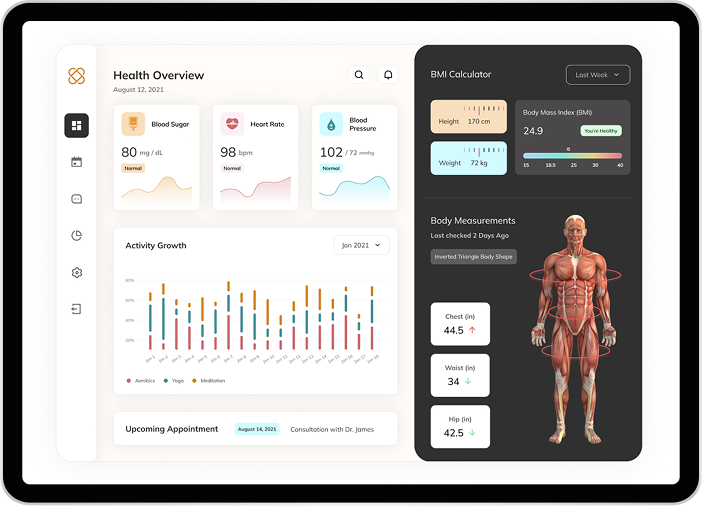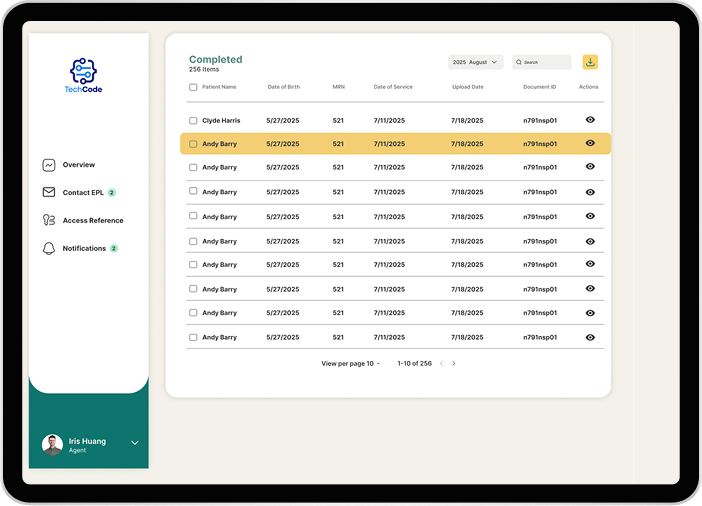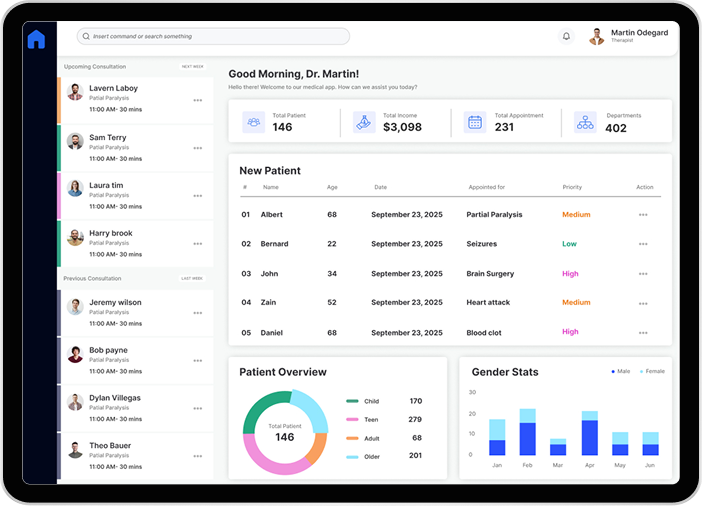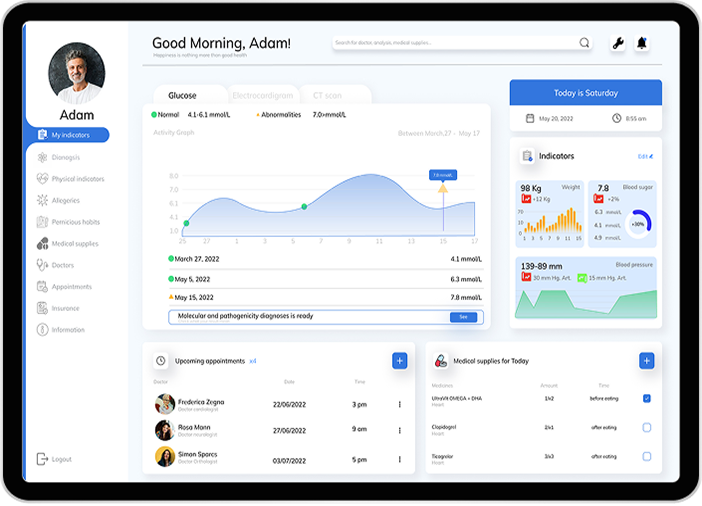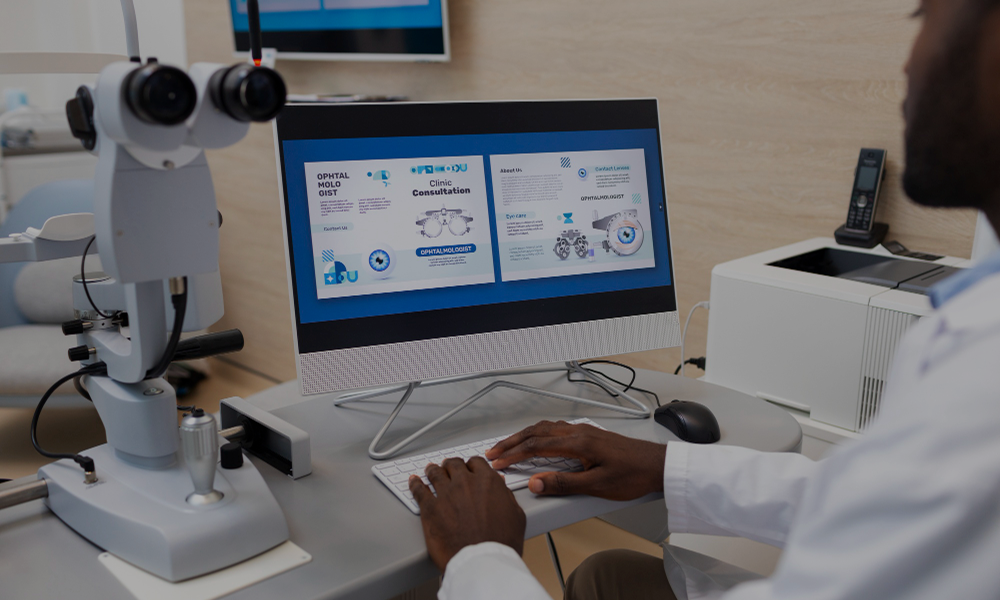Let’s build something great.
From the first line of code to production at scale, we turn healthcare challenges into software that performs, connects, and lasts.
Our Healthcare Software Development Portfolio
We engineer software for every facet of healthcare.



Who We Serve
We can help anyone building digital solutions that keep care connected.

Medical Practices

Healthcare software providers

Healthtech startups

Mental health providers

Nursing homes and assisted livings

Home care providers

Veterinary clinics and hospitals

Medical laboratories

Medical device manufacturers

Pharmaceutical companies

Medical biotech companies

Contract research organizations

Health insurance companies

Healthcare NGOs and GOs

Fitness and wellness companies
How We Make Healthcare Software Work
Our teams are fluent in the technologies, frameworks, and standards that keep your systems compliant and interoperable.
- HIPAA, HITECH, 21 CFR Part 11
- HITRUST, NIST Cybersecurity Framework, PCI DSS
- FDA Class I & II Software Guidance
- Data retention, audit logging, access control built into architecture
- HL7 v2.x (ADT, ORU, SIU), CDA, CCD
- FHIR (STU3, R4) with SMART on FHIR authorization
- NCPDP SCRIPT for ePrescribing
- ANSI X12 (837, 835, 270, 278) for claims and eligibility
- IHE Profiles, Direct Messaging, DICOM & DICOMweb
- Extensive experience with EHR platforms: Epic, Cerner, Allscripts, Athena, Meditech
- Worked across patient, provider, and payer-side systems
- Familiar with integration middleware (Mirth Connect, InterSystems, Rhapsody)
- SNOMED CT, LOINC, ICD-10, CPT, DSM-5
- RxNorm, CVX, NDC, DiagnosisRx
- DICOM for imaging workflows and PACS/RIS integration
- Genomic and precision medicine data pipelines and analytics environments
Discuss Your Healthcare Software Needs with Our Experts.
Why Choose Nalashaa
Our approach ensures your software launches strong — and stays strong.

We remain accountable for your timeline and targets. No last-minute surprises, no shifting expectations — just steady, reliable delivery.

Testing isn’t a checkbox — it’s part of how we build. From day one, every sprint includes automated checks, workflow validations, and review cycles.

We design compliance requirements from the start — with encrypted data flows, access controls, and full traceability built into the system.

Our systems are built to grow with your users, data, and needs — without rework. Whether you scale to a dozen clinics nationwide, performance holds steady.

Needs to evolve — your software should too. We structure our code, documentation, and deployment model, so you’re never locked in or left behind.
Added Services That Keep You Covered
Keep your product stable, secure, and ready for new demands with specialized support and testing.

Sustenance Services
Extend your product’s lifespan with proactive support and updates.
- L1–L3 support and minor feature enhancements
- Performance monitoring, tuning, and upgrade
- Release management and up-to-date documentation

Quality Assurance
Test every release for what stakeholders actually expect — performance, usability, and compliance.
- Functional, usability, and performance testin
- Automation frameworks to speed up cycles
- Security and compliance validation for healthcare standards
Let's Build Healthcare Technology Together
Bring your healthcare product ideas to life with expert engineering guidance.
Call Us:
732-602-2560
Mail Us:
info@nalashaa.com
Specialized Support for Your Ecosystem
We go beyond product development to solve the operational, regulatory, and technical challenges that come after launch.
Essential Guidance for Healthcare Software Providers
Frequently Asked Questions
Healthcare software development involves creating digital solutions tailored to the medical industry's needs. The process typically includes:
- Planning & Requirement Analysis: Identifying the specific needs of healthcare providers and patients.
- Design: Crafting user-friendly interfaces and system architectures.
- Development: Coding the software using appropriate technologies.
- Testing: Ensuring the software functions correctly and securely.
- Deployment: Releasing the software for use in real-world settings. · Maintenance: Regularly updating the software to fix issues and add new features.Howdy
This process ensures that the software meets regulatory standards and effectively addresses healthcare challenges.
Healthcare utilizes various software types to enhance patient care and streamline operations:
- Electronic Health Records (EHR): Digital versions of patients' paper charts.
- Telemedicine Platforms: Facilitate remote consultations between patients and doctors.
- Hospital Management Systems (HMS): Manage administrative tasks like scheduling and billing.
- Medical Imaging Software: Processes and stores imaging data like X-rays and MRIs.
- E-Prescribing Tools: Allow doctors to send prescriptions electronically to pharmacies.
- Clinical Decision Support Systems (CDSS): Provide healthcare professionals with data-driven insights.
- Remote Patient Monitoring (RPM): Tracks patients' health data outside traditional settings.
These tools collectively improve healthcare delivery and patient outcomes.
The SDLC in healthcare refers to the structured approach to developing software systems:
- 1. Requirement Analysis: Gathering functional and non-functional requirements.
- 2. Design: Creating system architectures and user interfaces.
- 3. Implementation: Coding software are components.
- 4. Testing: Validating the software against requirements.
- 5. Deployment: Releasing the software to users.
- 6. Maintenance: Ongoing support and updates.
In healthcare, adhering to the SDLC ensures compliance with regulations and the delivery of safe, effective software solutions.
- Several healthcare software solutions are widely adopted:
- Epic Systems: Comprehensive EHR platform used by large healthcare organizations.
- Cerner: Offers EHR and population health management tools.
- Allscripts: Provides EHR and practice management solutions.
- eClinicalWorks: Cloud-based EHR and revenue cycle management.
- Athenahealth: Offers network-enabled services for healthcare providers. Clarity Ventures
These platforms support various aspects of healthcare delivery, from patient records to billing.
Enterprise Resource Planning (ERP) in healthcare integrates core business processes into a unified system. It manages functions like
- Financial Management: Budgeting, accounting, and billing.
- Human Resources: Staff recruitment, scheduling, payroll.
- Supply Chain Management: Inventory tracking and procurement.
- Patient Services: Appointment scheduling and patient records.
Implementing ERP systems enhances operational efficiency and data accuracy across healthcare organizations.
Custom healthcare software is tailored to meet specific organizational needs, offering:
- Personalized Solutions: Address unique workflows and challenges.
- Scalability: Adapt to growing or changing requirements.
- Integration: Seamlessly connect with existing systems.
- Compliance: Ensure adherence to healthcare regulations.
By aligning closely with operational goals, custom software enhances efficiency and patient care quality.
Healthcare software must adhere to various regulations to ensure data security and patient safety:
- HIPAA (Health Insurance Portability and Accountability Act): Protects patient health information in the U.S.
- GDPR (General Data Protection Regulation): Governs data protection and privacy in the EU.
- FDA (Food and Drug Administration): Regulates medical devices and related software in the U.S.
- ISO Standards: International standards for quality and safety.
Compliance ensures legal operation and builds trust with users.
Telemedicine software enables remote consultations, increasing access to care, especially in underserved areas. Benefits include:
- Convenience: Patients can consult doctors without traveling.
- Efficiency: Reduces wait times and streamlines scheduling.
- Continuity of Care: Facilitates follow-ups and chronic disease management.
- Cost Savings: Decreases overhead for healthcare providers.
By leveraging technology, telemedicine improves healthcare accessibility and patient satisfaction.

